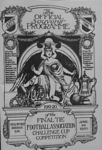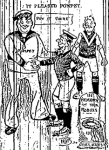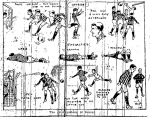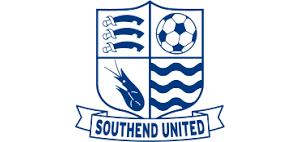Episode 23:
SOUTHEND UNITED ELECTED TO THE FOOTBALL LEAGUE
ELECTION TO THE FOOTBALL LEAGUE
Getting elected to the Football League sounds impressive, but it wasn’t in reality just a renaming of the Southern League to Division Three with 21 of the 22 Southern League Division One now in the Third Division, the exception was Cardiff City who despite only finishing fourth they WERE elected to the second Division, much to the annoyance of Portsmouth, their place being taken by Grimsby relegated from the second division.
Nevertheless this was a big move we were now part of the football league and whoever won that division would AUTOMTICALLY be promoted to the second Division
THIRD DIVISION FORMED
Mr. John McKenna, of Liverpool, presided over the annual meeting of the Football League, held on Monday, at the Connaught Rooms, Great Queens Street. More than usual interest was centred on the meeting in view of the anticipated debate concerning the Third Division, (which proposal was carried),and the problem also included the fact that seven clubs applying for the two vacant positions in the Second Division.
From the Southend Standard 3rd June 1920
The report went on at length stating that the proposal was for two Third Divisions a Northern and Southern section, the Southern League Clubs to make up the Southern section “on bloc”, while the Northern Section to be made up of clubs from various Leagues. The League representative spoke with “brutal frankness”, and said that the southern section should be accepted, but some of the clubs suggested for the Northern section should be put under careful financial scrutiny before being allowed admittance to the League. Cardiff were elected to the Second Division although they had only finished fifth in the table, much to the annoyance of Portsmouth who had won the Southern League, but as was gathered from the brutally frank words, finance was of more concern than playing ability.
******************************
SUMMARY FOR SOUTHEND UNITED 1919-20
FROM BANKRUPTCY TO SUCCESS
At the start of the season the only worry and priority had been to survive as a club, and this we certainly did. The ground had been the biggest obstacle, but the one year lease had guaranteed the survival of the season, The cup game at Sheffield and the sale of three payers had balanced the books and we had ended the season in a quite healthy financial situation. The general opinion of the team was that they were an average side but with a good spirit, this good spirit had to be down to the manager, but we had lost him to QPR a month before the end of the season, so there was a lot of uncertainty on the pitch for the future.
Two other problems had manifested during the season, firstly the extension of the lease on the Kursaal and secondly the behaviour of the fans. It seems strange that the leasing arrangement which seemed so amicable at start of the season, was suddenly a matter of contention six months later. Perhaps it was a feeling that better gates would be obtained in a more central location or a ground which was not so bleak in winter conditions. Thankfully these problems were overcome, a further move would have been expensive and put the club back further.
The behaviour of the fans which got such a bad press, was probably a commonplace occurrence with the world and attitudes having changed with the traumas of the First world War. When our “Enthusiasts” were described as the worst in the country, I wonder how many grounds the writer had visited post war. The Upper classes were desperately trying to maintain standards, but the working masses expected more, and needed, then as now, the outlet to let their emotions (and language) out in the escapism of football.
SEQUENCES
We managed 3 wins on the trot once, but drew 3 on the trot twice.
Aug to Nov The first 15 games were fairly mixed winning 4, losing 5 drawing the rest.
Nov to Jan The next 7 games up to the cup tie saw us win 3 lose 2 draw 2
Jan to Mar The next eleven saw only 1 defeat but 7 draws
Mar to May Easter brought only 1 point from 3 games, but then 3 wins on the trot, and finished the season with 1 point from 3 games again.
It was a season when we spent virtually totally in mid-table.
APPEARANCES and GOALSCORERS
Appearances: Marshall 44; Reid 42; Wileman 41; J. Young 40; Jones 39; Burrill 34; Bollington 32; Leahy 28; Evans and Woodward 26; Nicholls 23; Upex 18; Allen 15; Bridgeman and Emblem 13; Sands and Walden 11 each; Frost 8; Emery 7; Hill 3; R. Young and Liddell 1 each, (44 in all).
Goalscorers: Burrill 16; Wileman 8; Jones 6; Upex 5; Frost 4; Nicholls and R. Young 2 each; Bollington, Bridgeman and Walden 1 each, and 1 own goal (47 in all).
THE RESERVES
The point of having a reserve side, then as now, is not to win the league or even to especially win games but to bring on young players, experiment and as a stepping stone for getting back to the first team. However while not winning may not be a worry, to finish a humiliating bottom place having only won two of twenty eight games was frankly an embracement. Another consideration at this time was that the first team and reserve side would play at the same time, the general idea being that the first team would be at home one week the reserves the next and hopefully attract good crowds to both fixtures.
The South Eastern League before the war had had twenty ones sides, including Arsenal, Chelsea, Spurs and West Ham but had been greatly devalued when the London sides left to join the London League. Games against the big London sides would always attracted good crowds, but the opposition in the South Eastern league were not especially attractive.
However the major consideration as always was finance, the club found running a side in the South Eastern League almost as expensive as competing in the Southern League but without the financial return and this was the major reason that it was decided not to run a reserve team the following season
Leading Goalscorers; Upex and Schrier 5 each; Oakley and Rogers 4 each;
******************************
THE NATIONALSCENE
First Division
In the 1919-20 football league season West Brom won the first division by 9 points from Burnley, Chelsea came third, Sheffield United our cup opponents finished 14th. Notts County and the Wednesday were relegated to division 2
Second Division
Tottenham and Huddersfield were promoted from Division 2 and Lincoln and Grimsby were relegated, Lincoln to the Midland League while Grimsby were somewhat dubiously moved to the new Third Division.
Leeds City were expelled from the league. During the 1st World War there was a sequence of financial irregularities, including breaking the ban on paying players during the war, that led to the club's dissolution in 1919. They were expelled from The Football League eight games into the 1919-20 season Port Vale took over their remaining fixtures (as well as their results up to that point). In the wake of their Leeds City demise Leeds United were formed, and entered the Football League the following year. Leeds City's attendances were among the worst in the league, and the club was never particularly well financed. This is mainly attributed to the area being traditionally a rugby league area.
The English Cup (FA Cup)
In the Cup Sheffield United the current holders who had knocked Southend out in the 1st Round were surprisingly put out themselves by Bradford City three weeks later. The final was a typical northern affair with Aston Villa beating Huddersfield 1-0 at Stamford Bridge, but two Southern clubs had been in the semi finals
Chelsea and Bristol City, the venues for the semi finals being Stamford Bridge and Bramall Lane the home of Sheffield United

Aston Villa v Huddersfield 1920 Cup final Programme
Home International Championship
The first Tournament since the War and many players had been killed, wounded or retired, the first round of matches both ended in draws. In the second round Scotland and Wales both won, Wales claimed the Tournament when England defeated Scotland 5-4 in an exhausting match. Scotland and England both finished with three points, Ireland last with only two.
THE END






































